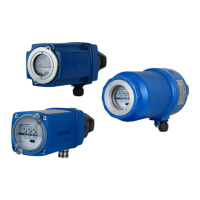13 Glossary
D-LX 201/721
115
13 Glossary
Background radiation
The radiation of static emitters such as glowing
boiler components can be modulated by com-
bustion air currents or flue gas vapours. If the
measured radiation is in the range of the flame
spectrum and the usual flicker frequency range
(approx. 10 to 200 Hz) for a flame, then the
flame monitor may incorrectly detect a flame sig-
nal. Radiation from the flames in other burners
can also be incorrectly detected as a flame sig-
nal.
DIP switches
are small switches which are used (e.g. on the
motherboard or other printed circuit boards) to
perform defined basic settings. The abbreviation
stands for dual in-line package, i.e. a configura-
tion with two parallel series of connections.
D−LX201 InformationCentre
The D−LX 201 InformationCentre is a DURAG
PC program with a graphical interface for the
system configuration, operation and manage-
ment of DURAG sensor devices. The software is
not necessary for operation of a flame monitor.
DURAG Modbus
The Modbus protocol is a communications pro-
tocol. Since 1979, because of its open structure,
Modbus has become a de facto standard in the
industry. The data are transmitted in binary form.
This form of the Modbus is designated as RTU.
The DURAG Modbus is based on this Modbus
protocol, and defines additional information over
and above it, such as register assignments.
FFDT
abbreviation for: flame failure detection time, see
flame failure detection time
Flame failure detection time
The flame failure detection time (FFDT) is the
flame monitor's response time to a failure of the
flame signal and the resulting deactivation of the
relay contact for the Flame ON signal. The FFDT
was formerly known as the safety time and is re-
ferred to as the "Detektionszeit bei Flammenaus-
fall" in German.
Flame intensity
The flame intensity is given by the flame signal
and conversion using the gain settings. It is digit-
ally calculated as a numerical value (from 0 to
2²³) and output as 0…100%.
Flame radiation
is the visible and invisible (IR/UV) light emitted
by the flame.
Flame signal
In the photo diode, the flame generates an (ana-
logue) current, which is then processed in the
analogue amplifier and the analogue filters. This
flame signal (AC/DC) is transferred to the micro-
controller inputs for further digital processing.
Harmonic detection
The flicker frequency of a genuine combustion
process will always fluctuate. A flicker frequency
that remains constant for several seconds can
therefore not originate from a flame. This situ-
ation is detected, and leads to an error shutdown
after 10 seconds.
Low NOx
In this combustion method, the flame temperat-
ure is reduced by recirculating exhaust gases
from the combustion chamber and the flame is
cooled. This enables a significant subsequent re-
duction in harmful substances, particularly nitro-
gen oxide, to be achieved.
RS485 interface
was developed analogously to the RS422 inter-
face for serial high-speed data transfer over
large distances and is becoming more and more
common in industry. The data cables must be
twisted in pairs.
Safety time
See flame failure detection time
Switching threshold
The switching threshold determines whether the
magnitude of the existing flame signal should
result in a Flame ON or Flame OFF signal. Only
flame signals with pulse rates higher than the
switching threshold can be rated as Flame ON.

